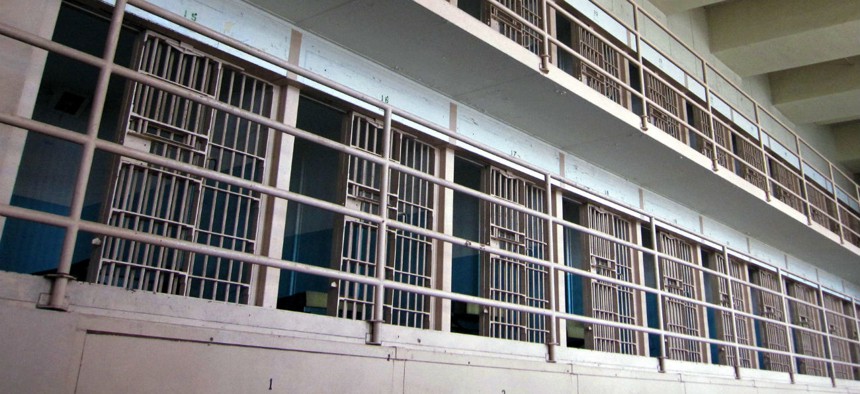
By Eirik Gumeny / Shutterstock.com
Federal Correctional Officer Suicides Sound Alarms at Bureau Of Prisons
Staffing levels are another major issue for the agency.
Suicides among federal correctional officers are a growing concern at the Federal Bureau of Prisons, according to the national president of the federal prison employees union.
The record for federal correctional officer suicides in a single year—14—was set last Friday with the death of a California federal correctional officer, said Shane Fausey, national president of the Council of Prison Locals C-33, a division of the American Federation of Government Employees. The bureau, however, says there have been a total of nine in fiscal 2019 and the beginning of fiscal 2020.
When asked about the discrepancies in the figures, Fausey said, “We track numbers from all local institutions and the BOP, when asked for statistical data, has self admitted that they do not track this information accurately.”
Fausey told Government Executive that he believes, based on his almost 30 years of experience working in the prison system, that staffing levels could be contributing to the high number of suicides. “You have to look at the overall picture to make a true assessment and I’ve never seen our staffing numbers so abysmal in my career,” he said. “I’ve never seen it this bad.”
Staffing shortages at the Federal Bureau of Prisons have been well-documented. According to a Justice Department Inspector General report released on Nov. 22, the bureau “has over 35,000 employees to provide care and custody for nearly 180,000 inmates, but projects that it will remain nearly 12% understaffed through 2020” at its 122 institutions nationwide. This report listed “managing a safe, secure and humane prison system” for inmates and employees as one of the top eight challenges that the Justice Department, BOP’s parent agency, is facing.
Across the federal prison system drug use and inmate violence prevail because “anytime you reduce the [level] of supervision your overall security starts to break down,” Fausey said. He noted that the bureau staffing numbers are lower due to the “mission critical” initiative implemented in 2005 to save money by reducing the prison workforce to the minimum needed. “We’re down about 10,000 positions” of the mission-critical levels “and that’s not including the number of new facilities that have come on line since that,” he told Government Executive.
The inspector general also reported that inmate suicides and homicides increased between 2016 and 2018. In the aftermath of financier and alleged sex trafficker Jeffrey Epstein’s death while in federal custody, Fausey said, “there seems to be very little focus or very little attention” on correctional officers’ suicides.
A bureau spokesperson told Government Executive in a statement:
The Bureau of Prisons is not immune to the stressors of a law enforcement environment. Providing a safe environment can take a toll on staff who work tirelessly to provide security for others. Although it is not common, staff suicide is something we address through a variety of means. These include a comprehensive Employee Assistance Program for all staff members and their immediate family members, The Battle Buddy Program for staff who are also Uniformed Service veterans, and educational resources.
Fausey said the bureau needs to have a standardized way to collect data on the deaths and debrief employees following a violent incident. He called on the agency to take a more proactive approach to determine the suicide triggers, measure trends and prevent future ones from happening.
Bureau Director Kathleen Hawk Sawyer testified before the Senate Judiciary Committee last week, “We have put such huge strains on the Bureau of Prisons trying to accomplish its mission,” and the vast majority of staff are good, hardworking employees, “but they are tired because they are stretched.” She attributed the resource problem to the rapid increase in the prison population in the last 30 years, employees retiring at a faster rate than they are hired, uncertain budgets, the recent government shutdown and the hiring freeze early in the Trump administration.
The bureau has been relying on augmentation to temporarily fill correctional officer positions with other staff. Although Hawk Sawyer testified that this is a good process and all staff are trained for this role, she admitted the agency has to use augmentation more than is optimal and often employees are taken away from their designated work.
Don Williams, father of a slain correctional officer who became an advocate for federal prison employee safety through his organization Voices of JOE, said he “felt that the issue of the staffing just got kind of lip service,” at the hearing. “Staff is being injured, inmates are being injured and you can’t operate facilities with everybody stressed out like this,” he said. “They have people working double shifts; they have people that haven’t spent time with their families. They’re worn out. They’re tired.”
Williams’ organization works closely with the union to learn about the issues federal prison workers face and fight for change. “We’ve been fighting for six years, ever since my son’s death, to try and get staffing numbers higher and instead they're going down,” he told Government Executive.
Following reports that at one institution, 105 officers had to work a mandatory double shifts for 10 days straight, Fausey said, “it’s not unique to that one institution. It’s a systematic staffing crisis. All of that extra pressure and stress on a highly stressful profession to begin with...it’s a recipe for a really bad storm.”







